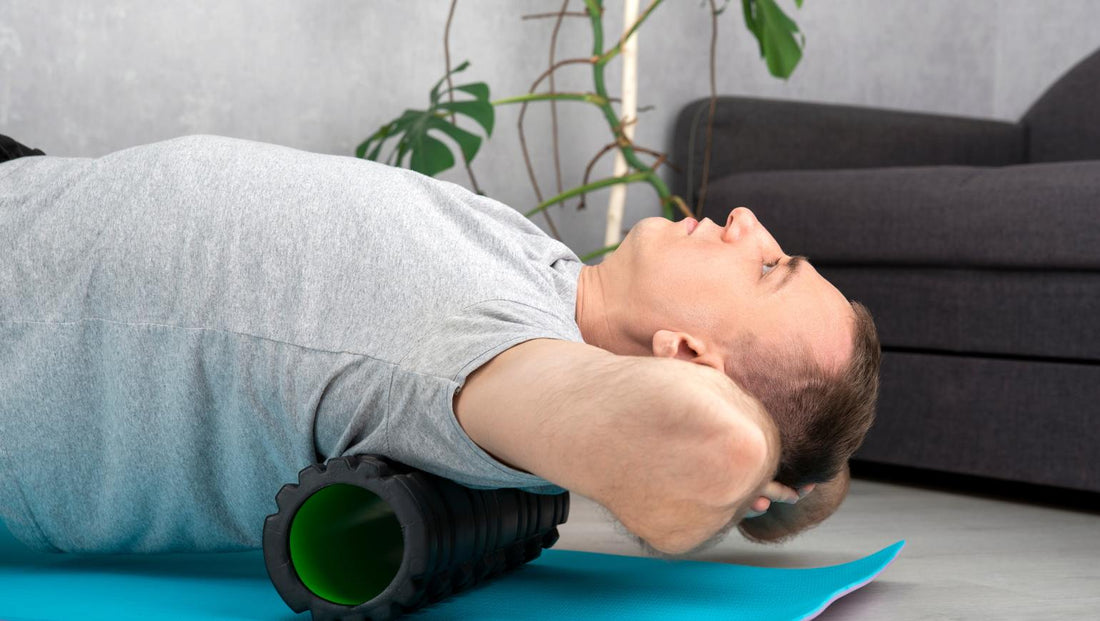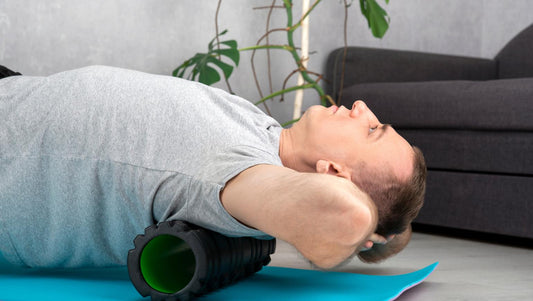What is SMR?
Myofascial release, or self-myofascial release (MFR/SMR), is a therapeutic technique that targets the fascia. Fascia is a connective tissue surrounding all your muscle fibers. SMR treatments help to relieve muscle tightness, trigger points, and restrictions in movement. Myofascial trigger points often develop due to chronic stress, poor posture, or injury, leading to localized pain and referred discomfort. The thoracic spine plays a crucial role in supporting upper back movement and posture, and limited mobility in this region can contribute to muscle tension. The mid trapezius, arms, and hip are also commonly involved in upper back tension, as trigger points in these areas can affect muscle function and movement. One of the areas where myofascial release can be particularly effective is the upper back, a region that holds a lot of tension due to body weight, daily activities, and emotional stress.
In this article, we’ll guide you through a step-by-step process for performing self-myofascial release on your upper back. You can use tools like foam rollers, massage balls, or even your hands to do myofascial release of upper back muscle knots and tightness.
Tools You Will Need for SMR:
-
Foam roller: There are a lot to choose from. Go with something small to medium-sized the first time. Not too heavy, not too hard, and not too complex. Your body will need some time to get used to the pressure. Going with a tool designed for the human anatomy like the RAD Helix, is also a good idea. You want to avoid rolling over the bone or causing any pain or guarding when you roll.
-
Massage balls: There are a lot of cheap products on the market that will wear out in a few months of regular use, so why not choose one that lasts? RAD provides a full line of SMR tools for every part of the body. Lifetime guaranteed.
-
Therapeutic massage tool: Some massage tools are just made to move the skin or just manipulate the fascia. Some are for deep tissue. Others are just for the back. Make sure you have at least one tool in your arsenal that's for overall, soft, therapeutic massage. These can be massage balls or soft rollers; tools that bring hydration and blood flow to the skin layers.
-
Flushing Rods: Incorporating a massage rod or massage stick is also a good idea. These tools are designed to flush acid and waste from the muscles and skin towards the center of the body so your system can process and eliminate them more quickly. This can reduce recovery time and delay the onset muscle soreness (DOMS). Great for a cool down, post-workout out and the next morning.
-
Comfortable, quiet space to perform the release. This can be a meditation studio, yoga room, backyard, or bedroom. Wherever you feel most relaxed.
-
Sanitizer: Cleaning up after an SMR session will make your tools last longer, and your skin will stay happier. Even fresh out of a shower, humans have body oils on their skin. Lotions, sunscreen, and sweat can also make it onto the surface of your tools. Grab a sanitizing spray for after every session, and make sure to clean them thoroughly once every few sessions.

Step 1: Prepare Your Space
Before starting, find a comfortable and quiet space where you can lie down or sit undisturbed. Ensure that you have all your tools within easy reach.
Step 2: Using a Foam Roller
A foam roller is an excellent tool for myofascial release in the upper back. It’s great for targeting large muscle groups and helps to improve flexibility and reduce muscle tightness.
Position Yourself:
Sit on the floor with your legs extended in front of you and your feet flat on the ground.
Place the foam roller horizontally beneath your upper back, just below the shoulder blades.
Engage Your Core:
Bend your knees and place your feet flat on the floor, ensuring your body is supported and stable.
Keep your core engaged to avoid straining your lower back.
Roll Slowly:
Use your legs to roll your body back and forth over the foam roller. Focus on rolling from your shoulder blades to the base of your neck, covering the entire upper back.
Move slowly, allowing your muscles to release tension as you roll.
Pause for a few seconds on any tight or tender spots, gently applying more pressure for a deeper release.
Target Specific Areas:
To release more targeted knots or areas of tension, roll side to side or pause on specific spots where you feel the most discomfort.
Breathe deeply and relax to allow the fascia to release tension.
Step 3: Using a Massage Ball
Massage balls, like a lacrosse ball, are ideal for targeting smaller, more localized areas of tension in the main muscles in the upper back.
Position the Ball:
Stand with your back to a wall or lie down on the floor. Place the massage ball between your upper back and the wall (or the floor) in an area where you feel tightness or discomfort.
Apply Gentle Pressure:
Slowly roll your body to move the ball around, targeting the upper back, shoulder blades, and the muscles along the spine. Focus on areas that feel particularly tight or sensitive.
Hold For a Deeper Release:
When you find a tender spot, hold the ball against the area for 20-30 seconds while applying gentle pressure. Breathe deeply to relax the muscles and allow the tension to release.
Adjust the Ball's Position:
If needed, adjust the ball's position to move it to different areas of the upper back, such as the trapezius or the rhomboids.
Step 4: Incorporating Stretching
After performing myofascial release exercises, it’s important to stretch the muscles in mid mid-back and the upper back to enhance flexibility and prevent future tension buildup.
Here are a few beginner stretches to really work the back and stretch out the spine.
Cat-Cow Stretch:
Begin on your hands and knees, with your wrists under your shoulders and knees under your hips. Inhale as you drop your belly toward the floor, lifting your head and tailbone (Cow pose).
Exhale as you round your spine, tucking your chin to your chest and pulling your belly button toward your spine (Cat pose).
Repeat for 5-10 rounds to stretch and mobilize the upper back.
Thread the Needle:
Begin on all fours, with your hands beneath your shoulders and knees beneath your hips.
Reach your right arm under your left arm and twist your torso, bringing your shoulder and head to the floor. Hold for 20-30 seconds, then switch sides.
This stretch helps release tension in the upper back and shoulders.
Step 5: Consistency is Key
To experience lasting benefits from self-myofascial release, consistency is essential. Incorporate this practice into your weekly routine to help prevent chronic pain and tightness in the upper back and improve mobility.
You can perform self-myofascial release up to 3 times a week, depending on your comfort level.
Additional Tips:
Breathing
Throughout the process, remember to breathe deeply. Inhale through your nose and exhale through your mouth to help your body relax and facilitate muscle release.
Intensity
Start with gentle pressure and gradually increase intensity as your muscles adapt to the treatment. Myofascial release should never be painful.
Hydration
Drink plenty of water after a myofascial release session to help flush out toxins and keep your muscles hydrated.
Conclusion
Myofascial release is an effective and simple technique to alleviate upper back pain and tension. By using tools like foam rollers and massage balls, combined with stretches, you can improve flexibility, increase strength, reduce discomfort, and support long-term back health.
Incorporate these techniques into your self-care routine for a healthier, more mobile upper back.




















